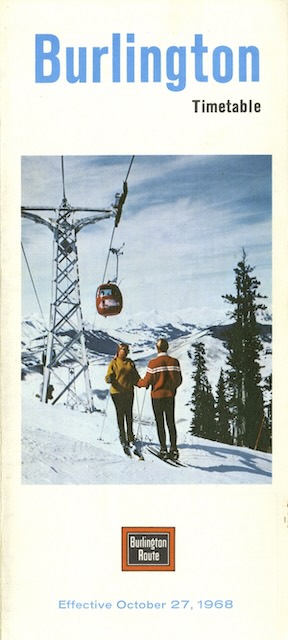Yesterday’s 16-page June 1968 timetable was quite a come down for a railroad that once published 44-page timetables. The shrinkage wasn’t over: Today’s edition is a folded brochure that is the equivalent of just six pages long, the same as the condensed timetables of earlier years. This made June 1968 the last Burlington system timetable that was folded and stapled.
 Click image to download an 2.9-MB PDF of this timetable.
Click image to download an 2.9-MB PDF of this timetable.
The cover shown above used just half a page. The once-centerfold map is reduced to just over half a page. The two-page list of Burlington agents is reduced to half a page. General information, the station index, condensed timetables, fares, and connecting trains are all gone.
One change in the continuing melodrama of the Twin Cities corridor is that the eastbound Western Star and Mainstreeter traded places. For the previous several timetables, the Star had been combined with the Afternoon Zephyr while the Mainstreeter had been combined with the Black Hawk. Starting with this one, it was the Star with the Black Hawk and the Mainstreeter with the Afternoon Zephyr.
This change was a terrible disservice to passengers on the Western Star. Under the previous timetable, the Star left Seattle at 10 am and passengers going through to Chicago had a 55-minute layover in St. Paul. Under today’s timetable, the train still left Seattle at 10 am but arrived in St. Paul three hours later than in the previous timetable, too late to connect with the Afternoon Zephyr. As a result, the St. Paul layover was extended to 4-1/4 hours. Since the Black Hawk was a little slower than the Afternoon Zephyr, this meant that Western Star arrived in Chicago 7-5/6 hours later than previous and the overall trip was longer by the same amount. The train no longer had through cars to Chicago so all passengers had to change trains anyway.
I’m not sure why Great Northern added so many hours to the Western Star‘s Seattle-St. Paul schedule that it added nearly 8 hours to the Seattle-Chicago trip. The railroad probably figured that few passengers rode that train all the way to Chicago so the connection wasn’t really important.
The Mainstreeter did a little better from the trade. Northern Pacific had moved its Seattle departure from 9:45 pm to 7:15 pm. This and other changes enabled it to get the train to St. Paul by 2:55 pm. Passengers could catch the Afternoon Zephyr ninety minutes later. Only the Mainstreeter‘s Slumbercoach went through to Chicago; coach passengers had to physically change trains. But the entire Seattle-Chicago journey was cut by 4-1/3 hours.
Other than this and a few other minor time changes, the trains shown in the June timetable were mostly intact in this one. Based on the economic logic I explained yesterday, any train on a route that had more than one train was worth keeping because the savings from eliminating only one train on that route was small. Somehow, the Kansas City Zephyr escaped that logic, but still nearly all of the routes that survived to this timetable have more than one train for most of their distance.

Leaving aside the issue of the service itself, the timetable presented here actually compares pretty favorably with those of the other roads serving the west. Union Pacific had color covers showing a map of its lines through the territory it served, while the interior pages were printed on newsprint. Likewise, SP used an even lesser grade of newsprint, although they used different ink colors for each timetable, presumably for easy IDing of which issue it was. Single color throughout.
The CBQ timetable is notable for its use of a color image on the cover. Remember, this was back in an era when 4 color printing was expensive and labor intensive. Note though that CBQ did save some printing cost by not having the image go all the way to the edge of the paper, which would have meant doing a bleed and then trimming the paper to size.